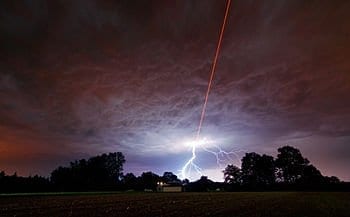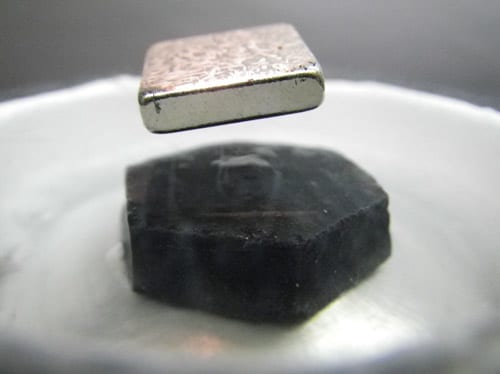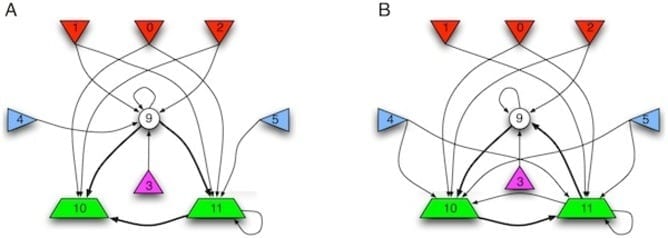
Coupling 2 ‘Tabletop’ Laser-Plasma Accelerators, a Decisive First Step Toward Tomorrow’s Ultrapowerful Compact Machines
Laser-plasma accelerators (LPAs) got the nickname “tabletop” because, as shown by the unique BELLA accelerator at the U.S. Department of Energy’s Lawrence Berkeley National Laboratory (Berkeley Lab), they can boost electron beams to multibillion electron-volt energies (GeVs) in a few centimeters—a distance thousands of times shorter than conventional accelerators.
Past those few centimeters, however, the laser pulse weakens and energy gain stalls. LPAs will have to get off the tabletop if they are to rival proposed conventional colliders, such as 30-kilometer-long electron-positron linear colliders or circular proton colliders 100 kilometers in circumference, with electron-volt energies in the trillions (TeVs), not billions. Only by coupling a hundred LPAs in series, each powered by a BELLA-class laser in series, and accelerating a well-shaped beam from one stage to the next, will such high energies be achieved.
“Long before planning began for BELLA, we’d set our sights on staging as the way to achieve energies needed for compact particle colliders, free-electron lasers, and other tools of future science,” says Wim Leemans, Director of Berkeley Lab’s Accelerator Technology and Applied Physics Division (ATAP)and Director of the BELLA Center. But because of the daunting technical challenges, including maintaining electron beams with dimensions measured in millionths of a meter and laser pulses measured in quadrillionths of a second (femtoseconds), Leemans says, “Lots of people told us we’d never be able to do it.”
In an experiment packed with scientific firsts, Leemans and his BELLA Center colleagues have now demonstrated that a laser pulse can accelerate an electron beam and couple it to a second laser plasma accelerator, where another laser pulse accelerates the beam to higher energy—a fundamental breakthrough in advanced accelerator science. The results are reported in the Feb. 1 issue of Nature.
Stable beams, disposable mirrors
Sven Steinke, lead author of the Nature paper, says that to achieve staging wasn’t about huge energy gains; the challenge was handing off a useful beam. “A billion electron-volts wouldn’t matter,” he says. “What mattered was stability,” an experiment that would work reliably for days at a time and many thousands of laser shots. “You don’t want to spend three-quarters of your day tuning your beam injector, with no time left to do an experiment.”
The solution was to use two different kinds of LPA. The more advanced but more finicky type is a discharge capillary, a block of sapphire with a thin horizontal tube through it. Hydrogen gas fills the tube; a potent electrical discharge ionizes it, separating electrons from their nuclei and forming a plasma. Almost instantly this discharge arc heats the plasma and forms a laser waveguide, a cylindrical channel of thinner plasma in the center; the incoming laser pulse drives through it like a speedboat on water, picking up free electrons in its wake and hurling them forward like a surfer on a following wave.
Another kind of LPA is a jet of supersonic gas a few hundred micrometers in diameter. The laser pulse drills through the gas, simultaneously ionizing it to form a plasma and leaving a wake to accelerate the free electrons.
The gas jet, conceptually simple but still capable of beam energies of over a hundred million electron-volts, was the team’s choice for stage 1, the beam injector. The more powerful discharge capillary, similar to the kind used in BELLA, would be Stage 2.
A critical challenge was how to introduce the second laser pulse, using a mirror, within the few-millimeter space between the two stages. The electron beam would have to pass through a hole in the mirror. The reflected laser pulse would come close behind. Unfortunately, to focus enough power to accelerate the electron beam, the laser focus would have to be so close to the mirror it would blow it to pieces.
“We decided from the beginning of the project that instead of worrying about blowing up the mirror, we’d blow it up with every shot,” says Leemans. They first developed a prototype mirror of water film, he says, “but settled for much more robust VHS tape.”
Video cassette players may be out of fashion, but VHS tape is thin, stretch-resistant, and capable of running for hours at a time. The electron beam pierces the tape virtually untouched. On the opposite side, in the merest fraction of a second before the laser pulse can penetrate the tape, it ionizes the surface to form a dense, perfectly flat plasma: a highly efficient mirror.
Steinke, whose dissertation involved plasma mirrors and who was a postdoc at the Max Born Institute in Berlin before joining the BELLA Center, characterized the mirror system for the staging experiment. Previous plasma mirrors were based on expensive solid optics made for completely different purposes. Steinke and Leemans agree: “This was the first use of a continuous, high-repetition-rate, disposable plasma mirror.”
A serendipitous plasma lens
The staging system was ready for its first test. In the gas-jet LPA, the first laser pulse created an electron beam that passed through the tape, while the plasma mirror reflected the second laser pulse. Electron beam and laser pulse both entered the stage 2 capillary.
No beam came out.
The Latest on: Laser plasma accelerators
[google_news title=”” keyword=”laser plasma accelerators” num_posts=”10″ blurb_length=”0″ show_thumb=”left”]
via Google News
The Latest on: Laser plasma accelerators
- NASA's Proposed Plasma Rocket Would Get Us to Mars in 2 Monthson May 8, 2024 at 2:35 pm
The space agency is investing in the development of a propulsion system that uses nuclear power to create plasma bursts.
- Machine learning harnessed toenhance high-power laserson May 2, 2024 at 5:41 am
The experiment took place at the ELI Beamlines Facility in the Czech Republic, where the researchers utilised the state-of-the-art High-Repetition-Rate Advanced Petawatt Laser System (L3-HAPLS) to ...
- Laser-driven particle accelerationon April 25, 2024 at 3:56 am
The two approaches — laser wakefield and ion beam accelerators — promise reductions ... to the speed of light and 'ride' along on the plasma wave, gaining energy while they do so.
- Principles and applications of compact laser–plasma acceleratorson April 23, 2024 at 5:00 pm
The development of laser–plasma accelerators began in the early 1980s, inspired by the pioneering work of Tajima and Dawson 1. Key to their operation is the fact that unlike the superconducting ...
- Plasma Physics newson April 22, 2024 at 4:59 pm
In the nine decades since humans first produced fusion reactions, only a few fusion technologies have demonstrated the ability to make a thermal fusion plasma with electron temperatures hotter ...
- 3D Structure of Powerful Laser-Driven Electron Beam Revealedon April 10, 2024 at 9:25 am
Dawson that uses high-intensity laser pulses to drive plasma waves with acceleration gradients orders of magnitude higher than those of traditional RF-based accelerators. By considering the laser ...
- Dielectric laser accelerator creates focused electron beamon April 9, 2024 at 5:00 pm
How it could work: electrons are injected into the dielectric laser accelerator (centre) from a source at the top left. The cavities are within the turquoise and gold bars, which are illuminated with ...
- Electro-optic 3D snapshot of a laser wakefield accelerated kilo-ampere electron bunchon April 8, 2024 at 5:00 pm
harnesses the power of high-intensity laser pulses to drive plasma waves with acceleration gradients orders of magnitude higher than conventional RF-based accelerators. Treating the laser pulse as ...
- Scientists make a laser accelerator with 10 billion electron-volt beamon November 30, 2023 at 2:49 am
Accelerators were first ... and electrons ride this plasma wave like surfers,” described the university. World's most potent pulsed laser utilized Researchers employed the Texas Petawatt ...
- Accelerating Electrons To TeV Levels Using Curved Laser Beamson August 1, 2023 at 9:19 pm
Here laser wakefield accelerators (LWFAs) are a promising alternative, which uses lasers to create accelerated particles along the wake in a plasma field. One of the major struggles has been with ...
via Bing News










